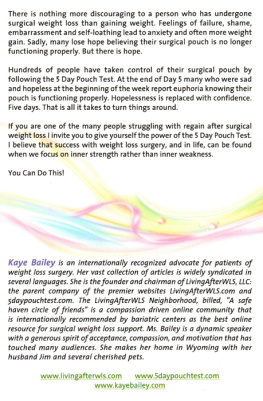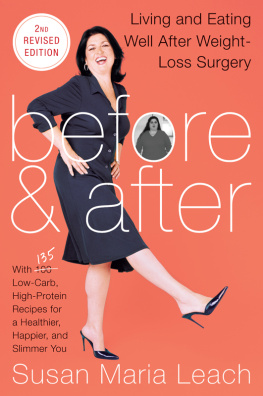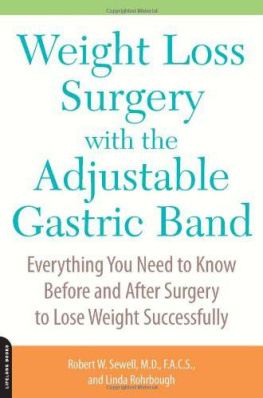
FIGHTING WEIGHT
How I Achieved Healthy Weight Loss
with Banding, a New Procedure
That Eliminates HungerForever
Khaliah Ali Dr. George Fielding, Dr. Christine Ren, Lawrence Lindner

To my son, Jacob
And to all children whose parents have opted out
of too many photos with them
CONTENTS
Introduction Claiming Your Life
Blubbery
Bad to Worse
The Cinderella Years
Crisis Point
Gut-Level Bond
Changing My Sail
A New Day Dawns
The Color Line, Thick and Thin
A Call to Arms
On My Way
Acknowledgments
Khaliahs Charities
Searchable Terms
About the Authors
Credits
Cover
Copyright
About the Publisher
This book is designed to give information on the medical procedure known as laparoscopic adjustable gastric banding and about diet and weight loss generally. It is meant to help you be a more informed consumer of medical and health services. It is not intended to be complete or exhaustive, nor is it a substitute for the advice of your physician. Every person is different, and what is a good medical decision for one person may not be the best decision for another. Only you and your personal physician can determine what is best for you.
All efforts have been made to ensure the accuracy of the information contained in this book as of the date published. The authors and the publisher expressly disclaim responsibility for any adverse effects arising from the use or application of the information contained herein.
INTRODUCTION
CLAIMING YOUR LIFE
T wenty million Americans cant pull an airplane seat belt across their laps. They cant run for a train, cant step into the bathtub without great deliberation, and cant push a child on a swing. Nor can they sit on a bistro chair or other fragile furniture because, quite simply, theyd break it. Most dont dare go to the beach, wear sleeveless shirts, hold out hope for true romance, or enjoy being in public.
All are candidates for weight-loss surgery. Beside the everyday mortification of literally not being able to fit into life, theyre susceptible to heart disease, diabetes, arthritis, interruptions in breathing during sleep, and a host of other debilitating, if not life-threatening, conditions.
Still, less than 1 percent of those eligible for obesity surgery come forward, largely because they fear the risks of the operation. I was one of them.
I know firsthand the shame of becoming morbidly obese; the lifetime of dieting off pounds, but never enough, and then gaining them all back and more; the aching joints, the inability to walk up a single flight of stairs without losing my breathall made worse by the fact that I was the daughter of a man who is very famous, in large part, precisely because of his fitness and physical abilities. I remember well, too, the experience of finally coming around to the idea of weight-loss surgery but rejecting it because of the very real possibility that I would die on the table.
A year after I gave birth to my son, Jacob, I ballooned up to my highest weight ever325 pounds. I feared for my life. I feared for my son, worrying that he would grow up without his mother. I feared going on any more diets because, as I learned all too well, very, very few people can diet off more than 100 poundsand keep them off. And I feared gastric bypass surgery because one in two hundred patients doesnt recover from it, a risk that was just too great.
Frightened and miserable, I went five years losing and gaining the same fifty pounds and didnt know which way to turnuntil a wonderful friend steered me toward Drs. George Fielding and Christine Ren, professors at the New York University School of Medicine. My friend told me they performed a type of weight-loss surgery that has been used in Europe for more than a decade but is only now starting to take off in the United States. The results of the surgery are just as spectacular as those of gastric bypass, she said, yet with only one-tenth the rate of life-threatening complications.
I didnt believe her. But desperate, I did finally read about Drs. Fielding and Ren on the Internet. Then I went to see them, propelled in part by the fact that they have performed more of this European type of weight-loss procedure than any other doctors in the world. (More recently, their practice was named one of only four better performers out of twenty-nine bariatric surgery practices rated by the very prestigious University Healthcare Consortium.)
Soon, with their record of success and also their hand-holding through my own hand-wringing, they convinced me of the procedures safety, and I was on the road to slimming down to a goal weight of 150 poundsnot bad for a woman whos five feet nine inches.
I have a debt of gratitude to Drs. Fielding and Ren that can never be repaid. How can you repay someone for giving you your life? So, when they asked me to do this book with them as a way of dramatizing what a very obese person goes throughand how she can come out the other sideI was thrilled to take part. Please be aware as you read that while the story is mine, all the scientific facts, figures, research, and medical explanations are theirs.
THE EUROPEAN SOLUTION TO OBESITY
The type of procedure I underwent is called laparoscopic adjustable gastric banding, or gastric banding, for short. (You can also call it stomach banding, because thats what it is.) It doesnt involve stapling your stomach and cutting your intestine in two, as does gastric bypassthe surgery chosen by such notables as Carnie Wilson and Al Roker. Instead, its relatively low-tech as operations go. A band is simply placed around the stomach and periodically tightened to reduce hunger sensations, as well as limit the amount of food you can process at one time. Thats it.
The operation was perfected by Dr. Fielding, who developed the technique that is presently used worldwide to implant the band. It offers myriad advantages over gastric bypass.
- 1. Its reversible. If you dont like the band, you can have it removed. Gastric bypass, by contrast, is a decision you usually cant go back on because the complication rate for reversing the surgery is too risky.
- 2. Low rate of postoperative problems. There are fewer adverse effects from the operation and even fewer deathsone in two thousand, as opposed to gastric bypasss one in two hundred.
- 3. More patient follow-up because you need to have the band tightened every so often. Its a simple outpatient procedure that involves no anesthesia, just an injection of watery solution that thickens the band so it can wrap a little tighter around the stomach. Ive had mine tightened a number of times now. Its about as eventful as getting your teeth cleaned.
- 4. No hunger. With gastric bypass, hunger eventually returns because the stomach softens up, or stretches, and theres nothing that can be done, which is why the weight of most people who have gastric bypass drifts upward again. With gastric banding, the periodic band tightening keeps hunger at bay forever so the weight can keep coming off as you need, and stay off. Even dieting plateaus dont sabotage the weight-loss effort. Usually, when obese people reach a plateau and stop losing weight for a while, the hunger combined with the disappointment of not seeing the scale needle move downward decreases motivation, so weight starts to creep back up. I know the pattern all too well. But with the band, the plateau is bearable. It can be waited out until the next drop in pounds because theres no hunger involved.
Next page












